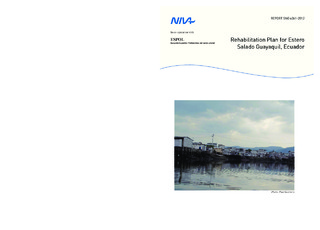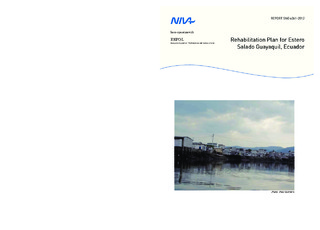| dc.contributor.author | Berge, D. | nb_NO |
| dc.contributor.author | Geerders, Paul | nb_NO |
| dc.contributor.author | Domingez, Luis | nb_NO |
| dc.contributor.other | Berge, D. - Project manager | nb_NO |
| dc.coverage.spatial | | nb_NO |
| dc.date.accessioned | 2014-08-01T10:57:39Z | |
| dc.date.available | 2014-08-01T10:57:39Z | |
| dc.date.issued | 2012 | nb_NO |
| dc.identifier | 6361 | nb_NO |
| dc.identifier.isbn | 978-82-577-6096-0 | nb_NO |
| dc.identifier.issn | 1894-7948 | nb_NO |
| dc.identifier.uri | http://hdl.handle.net/11250/215958 | |
| dc.description.abstract | The Municipality of Guayaquil invited the Norwegian Institute for Water Research (NIVA) and P. Geerders Consultancy (PGC) from Holland to participate in a two days field visit to the Estero Salado followed by a three days’ workshop in Guayaquil together with national experts from Ecuador as an attempt to revive, and add new perspectives to the plans and process of rehabilitation of the Estero Salado. The workshop comprised broad participation of all relevant authorities both from the Municipality of Guayaquil, as well as from the national ministry level (from Quito), stakeholders from the settlements in the Estero Salado area, from the INOCAR (Oceanographic Research Institute of the Navy, which shares the responsibility for the management of the Estero Salado with the Municipality), from the INTERAGUA (the company responsible for water supply and wastewater treatment), from several universities and consulting firms, as well as several NGOs which are engaged in different projects in the Estero Salado, as well as international experts. 34 abatement measures were identified comprising what could be done to reduce the external pollution loading from the catchment (catchment external measures), what could be done with abatement actions within the Estero itself (Estero internal measures), what could be done with and by the local population (environmental awareness programmes, participation, ownership, etc., socioeconomic measures), and finally what could be done concerning management practises, regulations, rules, clarifying the responsibility of the different authorities, etc., (management / governance measures). Care will be taken to implement measures in a holistic approach, avoiding that solving one problem would create another. | nb_NO |
| dc.description.sponsorship | Municipality of Guayaquil, Ecuador | nb_NO |
| dc.publisher | Norsk institutt for vannforskning | nb_NO |
| dc.relation.ispartofseries | NIVA-rapport;6361 | nb_NO |
| dc.rights | Navngivelse-IkkeKommersiell-DelPåSammeVilkår 3.0 Norge | nb_NO |
| dc.rights.uri | http://creativecommons.org/licenses/by-nc-sa/3.0/no/ | nb_NO |
| dc.subject | wat. res. man. | nb_NO |
| dc.title | Rehabilitation Plan for Estero Salado, Guayaquil, Ecuador – Scoping phase | nb_NO |
| dc.type | Research report | nb_NO |
| dc.rights.holder | Norsk institutt for vannforskning/Norwegian institute for water research | nb_NO |
| dc.subject.nsi | VDP::Matematikk og naturvitenskap: 400 | nb_NO |
| dc.source.pagenumber | 32 | nb_NO |
| dc.subject.keyword | vannforurensning | nb_NO |
| dc.subject.keyword | saltvanns estuarie | nb_NO |
| dc.subject.keyword | byutvidelse | nb_NO |
| dc.subject.keyword | guayaquil | nb_NO |
| dc.subject.keyword | water pollution | nb_NO |
| dc.subject.keyword | sea water estuary | nb_NO |
| dc.subject.keyword | city expansion | nb_NO |
| dc.subject.keyword | guayaquil | nb_NO |
| dc.relation.project | O-10255 | nb_NO |


